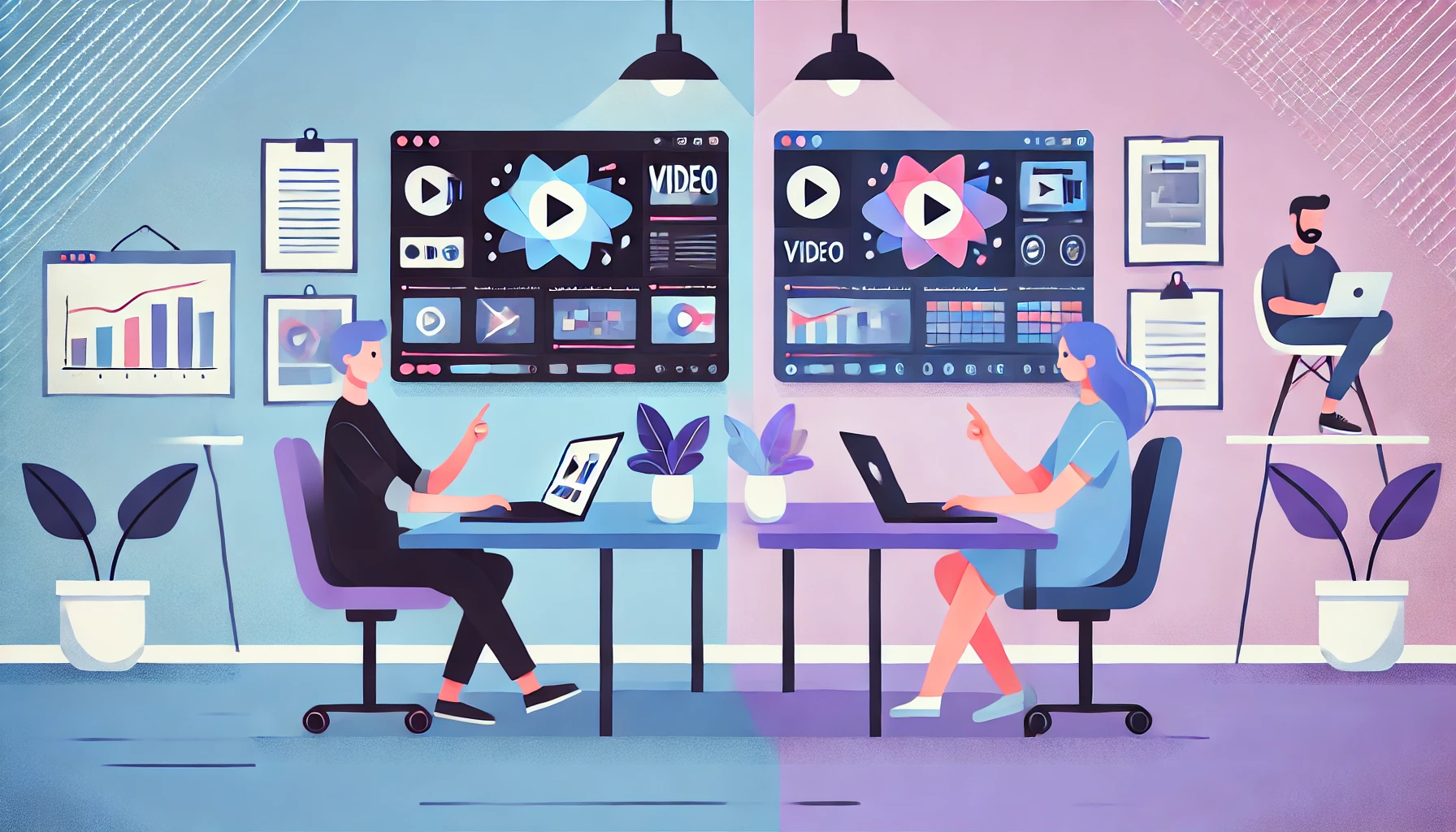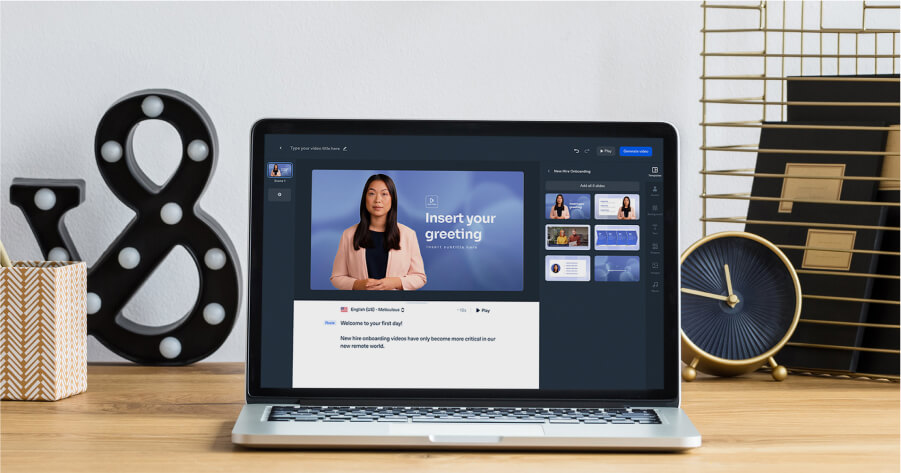
Create AI videos with 230+ avatars in 140+ languages.
Video production is an art form. From the classic films recorded by bulky motion picture cameras in the 1890s to the effects-heavy high-definition videos of the 21st century, creating engaging video content has always taken some serious skill.
But even though modern video equipment helps you create visually stunning videos without too much technical know-how, the creative process and execution come with plenty of challenges for video creators.
This blog post will help you fill in the missing element of preparation.
We’ll walk you through the video production process step-by-step, from the initial spark of an idea to the final cut of your video content. All so you can set your expectations and get started with knowledge and confidence.
What are the steps of the video production process?
Video production takes time, experience, and skill. Whether you use a video production team or take the DIY route, your video production process will unfold across three distinct phases:
- Pre-production phase
- Production phase
- Post-production phase
Preparation is vital to a successful video production process for even the most experienced video production company. Understanding each phase's steps and commitments helps you allocate resources for video content creation and schedule for a smooth production process.
The pre-production phase includes all the prep work and sets the stage for your video. It doesn't involve any actual filming but all the crucial planning and takes more than one pre-production meeting. You brainstorm a core message and map out what your video will be about, moving from concept to scripting and storyboarding. Then, you scout locations, cast talent, and schedule the shooting. The final steps in the pre-production stage are gathering all the equipment you'll need and doing one final pre-production meeting.
The production phase is the execution, where you implement the pre-production plans and start shooting all the footage that will serve as video content. Being on set to direct talent, operate cameras, and ensure that every shot and the sound recording are just right is such a busy and dynamic experience. Sometimes, things don't go as planned, and that’s where the vision of the director and leadership of the video producer come into play.
In the post-production phase, your video comes together, reflecting the core message. Almost entirely done on a computer, the post-production phase is about editing and refining the footage you've shot during production. It’s where you tell your story, deciding which shots to use, how they fit together, and the overall rhythm and pace of the video.
Why is the video production process important?
The video production process is important because it helps increase the predictability of your budget and the quality of the video you produce.
Creating a single short-form video comes with an average price tag of $1500 to $10,000 per minute. That’s a big investment for any business, and it explains why people spend so much time following a clear production process.
Knowing your video production process allows you to plan adequately for known variables (such as hiring actors) and things that don’t go as planned (like when your location permit doesn’t come through).
More than logistics, a clear production process also enables you to create videos that reach their full potential to engage, inform, and entertain. This aspect dictates the quality of the final video and the return on your investment.
The step-by-step pre-production process
The pre-production phase is that crucial time before you even think about hitting the record button on your video camera or smartphone. All the planning you do is like the planning phase of a big trip, where you map out where you're going, what you'll need, and who's coming along for the ride.
So, here are the key elements you need to finalize in the pre-production of your video project to ensure a smooth and efficient shooting process.
1. Create a video strategy
First, develop a game plan. Your strategy should involve knowing who will watch your video (your audience) and what you want viewers to take away from it. Set a timeline and a budget, too, because how much time you have and how much you can spend dictate what you can achieve.
2. Outline your content and write your script
Next, you decide what your video content is about, the story, and the message you’re sending. All this goes into a script, a written document that outlines the content and the scene-by-scene video structure.
A script or a bullet list with main ideas is enough for simple productions, whereas, for complex videos, you must also draw a storyboard based on the script.
It's also a good idea to write a shot list detailing all the people and gear you'll need in each scene. While it might feel like a complex process to do this for every scene, all these details will help you create a truly effective video.
3. Scout the location
Location scouting is similar to choosing the perfect backdrop for a photo — the setting can make all the difference. The location that’s most simple to use is the office space you already own or rent. If your video project needs a different setting than an office, like somewhere outdoors or a filming studio, location scouting involves checking locations, renting options, and necessary permits.
4. Find the right talent
Actors and voiceovers will bring your script to life. Depending on your video production goals, you can hire an actor or look for a subject matter expert or a friendly face at your company. Taking this route, you might need to do casting for actors or even hire a voice actor online.
AI is an alternative that can help you get quality narrations in various languages and even clone an employee into an AI avatar to use them in multiple productions without them showing up on camera every time.
5. Schedule the shoot
This step is all about timing and a bit like organizing a get-together — you need to ensure everyone can make it and everything happens at the right time.
6. Gather all the equipment
The last thing you want is getting on set and realizing you don’t have all your camera equipment, like spare batteries or enough memory cards. So, this is where having a shot list helps a lot because you can quickly go through it and check you have everything necessary for filming.
The step-by-step production process
Video production is the heart of the filmmaking process, where the real action happens. This production phase includes all your plans and ideas from pre-production that now come to life, hopefully just as you envisioned them in your script and storyboard.
7. Shoot the video footage
A successful video shoot starts with setting up all your equipment — cameras, lights, microphones, etc. Doing a tried and tested video process also helps; for example, running some warm-up rehearsals for everyone in your video production team is an easy way to get everyone comfortable in their roles.
When it's time to roll the camera, start shooting your scenes, and capture your B roll. B-roll footage is extra clips that support your story, like shots of the environment or objects, that will be super helpful when editing.
8. Record the sound
Good sound recording is critical to making your video feel professional and immersive.
You'll record dialogue and other sounds that add depth to your video — background noises, sound effects, or ambient sounds that make your scenes more realistic and engaging.
The step-by-step post-production process
Post-production is right after the filming process ends. This behind-the-scenes magic transforms your raw footage into a polished, final product ready for the world to see. Something that will make your video team really proud.
9. Edit and polish the footage
In the post-production stage, it is the job of your video editors to string together the best shots from your video project. They take all the raw materials, trim the parts that don't work, and create the right video length. The editing time they'll need depends on the footage's quality and the project's complexity.
Once visuals are in place, you layer in the sound — the dialogue you recorded, some cool sound effects, or maybe a catchy background track to set the mood.
Graphics and visual effects come next. They add that extra flair to your video, and if the content asks for it, add text overlays, animated logos, or even special effects.
After all these elements are combined, it's time to render your actual video. Rendering is the final step in the video editing process, where everything is compiled into the final video. Depending on your chosen video editor, check out what options you have to render for optimal video playback.
10. Distribute the finished video
Once your high-quality video is rendered and ready, it's time to share it with your target audience. This could be uploading it to social media, sending it to your marketing team, presenting it to your clients, or any other way you plan to distribute it. This last step in the post-production phase aims to get your video out there for people to see and enjoy.
Speed up your video production process with AI
Introducing AI into your workflow doesn't just add a techy edge — it streamlines the entire process, transforming the traditional 10-step journey into a sleek, efficient 4-step walk in the park.
Here’s how AI innovates video production, making it quicker, smarter, and more creative, all reflected through the video production process steps:
With the right AI tool and a 'video team' of one person, you can skip working with a video company and make your own videos in-house. All while significantly reducing your workload and not compromising the quality of your video project.
For example, Zoom chose the AI video maker Synthesia and trained an internal production team on creating video content. This decision accelerated their training video production by 90%, producing 200+ micro videos with up to $1,500 in cost savings per employee with the help of the AI video maker Synthesia.
Interested in doing the same for your company? Create an AI video for free to learn how to integrate AI into your video production.
About the author
Learning Strategist & Speaker
Elly Henriksen
Elly Henriksen is a accomplished instructional designer exploring the impact of AI-generated content on learning design. With eight years of experience across both professional and higher education institutions, notably The University of Washington, Elly provides an insightful perspective on the transformative power of synthetic media for learners and instructional designer. Her versatile roles, from course facilitator to eLearning author and LMS administrator, give her a unique vantage point on the evolving trends in instructional design and how AI impacts the learning landscape. Explore Elly's insights and her pursuit of leveraging AI to redefine the future of the learning world.














